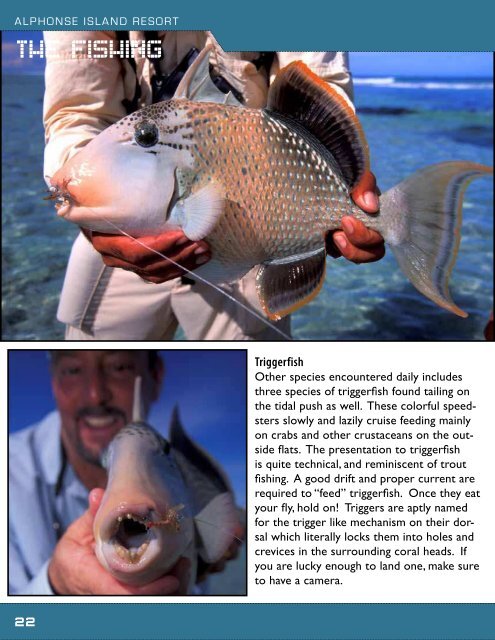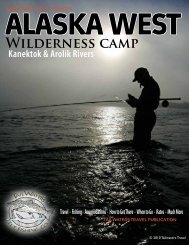AlPhONSE ISlANd RESORt - Tailwaters Fly Fishing Co.
AlPhONSE ISlANd RESORt - Tailwaters Fly Fishing Co.
AlPhONSE ISlANd RESORt - Tailwaters Fly Fishing Co.
You also want an ePaper? Increase the reach of your titles
YUMPU automatically turns print PDFs into web optimized ePapers that Google loves.
alphonse island resort<br />
THE FISHING<br />
seychelles<br />
Milkfish<br />
Perhaps the most intriguing species encountered<br />
in the Seychelles is the mighty milkfish.<br />
Although found throughout the Pacific<br />
and Indian Oceans, the milkfish that inhabit<br />
St. Francois are some of the largest in the<br />
world, and more importantly the guides have<br />
recently discovered how to catch them!<br />
The milkfish is similar in shape as a bonefish,<br />
only reach up to thirty pounds and possess<br />
a large sickle tale and huge eyes. When the<br />
milkfish are feeding on the surface, anglers<br />
present a grass or algae imitation and hope<br />
that one mistakes the green fly for a meal.<br />
When the fishing for milkfish is “on” success<br />
rates hooking milks are actually quite high<br />
despite the rumors of them being extremely<br />
difficult to hook. Finding them feeding in<br />
the proper fashion on the surface is the<br />
hard part, but once discovered on feeding<br />
properly they can be hooked with regularity.<br />
Over five hundred Milkfish have been caught<br />
and landed by Alphonse guests to date, with<br />
more than twice as many hooked. Some<br />
experienced guides say that at thirty pound<br />
milkfish will give a one hundred pound tarpon<br />
a run for his money, so landing them is<br />
another story!<br />
Triggerfish<br />
Other species encountered daily includes<br />
three species of triggerfish found tailing on<br />
the tidal push as well. These colorful speedsters<br />
slowly and lazily cruise feeding mainly<br />
on crabs and other crustaceans on the outside<br />
flats. The presentation to triggerfish<br />
is quite technical, and reminiscent of trout<br />
fishing. A good drift and proper current are<br />
required to “feed” triggerfish. Once they eat<br />
your fly, hold on! Triggers are aptly named<br />
for the trigger like mechanism on their dorsal<br />
which literally locks them into holes and<br />
crevices in the surrounding coral heads. If<br />
you are lucky enough to land one, make sure<br />
to have a camera.<br />
22<br />
23










